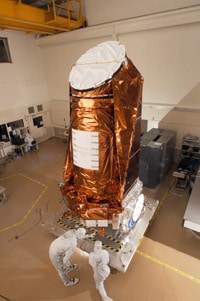NASA’s planet-hunting Kepler mission, scheduled for launch in 2009, recently survived an extreme temperature test. The thermal vacuum test is part of a series of environmental tests the spacecraft will undergo before it soars into space aboard a Delta II rocket from Florida’s Caper Canaveral Air Force Station. The test, which was performed at Ball Aerospace and Technologies Corporation, simulates the vacuum of space and the extreme temperatures Kepler must endure after launch. The spacecraft is placed in a vacuum chamber and is surrounded by a cold shroud to mimic the deep chill of space. The side of the spacecraft with the solar panels is then baked as if it were being heated by the sun. Having passed this thermal challenge, Kepler will now undergo electromagnetic compatibility testing to ensure that its electronics are sound. Once launched, the Kepler Mission will monitor 100,000 stars searching for signs of planets—including ones as small, or smaller than, Earth.Read more about the Kepler Mission at the Ball Aerospace and Technologies website.
NASA’s Kepler Spacecraft Slated for EMC Testing





